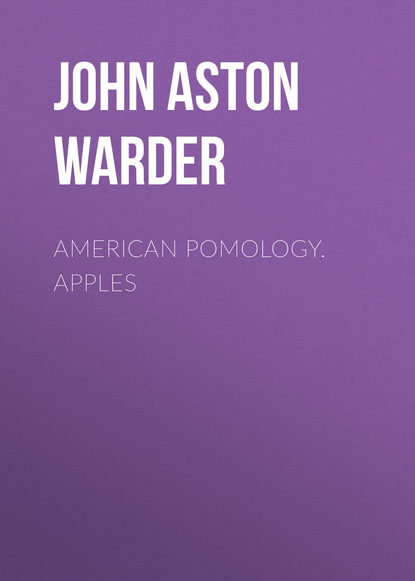 Полная версия
Полная версияAmerican Pomology. Apples
Different from Pound Royal of Downing, which is a winter-keeping fruit.
Ridge PippinThis fruit appears to be quite a favorite market apple in the neighborhood of Philadelphia, where it originated.
Fruit rather large, round-conic, very irregular, ribbed; Surface yellow, lightly shaded and blushed with red, and sprinkled with russet and crimson spots.
Basin abrupt, furrowed and folded; Eye small, closed.
Cavity wide, regular; Stem short.
Flesh yellow, crisp, juicy; Flavor mild sub-acid, rich.
Season, until March and April.
The Cook's FavoriteThis nice autumn apple comes to me from Oliver Albertson, a prominent and intelligent cultivator in Washington County, Indiana, marked "Best." Origin unknown.
Fruit medium, flattish-conical, angular; Surface smooth, whitish-yellow; Dots minute.
Basin deep, folded, ribbed; Eye medium, closed.
Cavity wide, wavy, brown; Stem long, slender.
Core medium, roundish, closed, meeting the eye; Seeds numerous, dark; Flesh yellow, breaking, tender; Flavor sub-acid; Quality quite good; Use, kitchen especially—"cooks very well;" Season, September.
Trenton EarlyThis fine autumn apple has been thought to be the English Codling. Of its origin and history we know little, except that it was one of Silas Wharton's varieties, and that it has been a great favorite wherever known. It was introduced to the notice of the Ohio Pomological Society, 1852, by R.W. Steele, Esq., of Dayton, Ohio, with the following notes: "A large, white apple, of excellent flavor, and is highly esteemed both for eating and cooking. It ripens in August. The tree is a vigorous grower and an abundant bearer. It was introduced here many years ago by Silas Wharton, of Warren County, to whom this portion of the Miami Valley is largely indebted for the introduction of many excellent varieties of apples and pears."
Fruit large, conical, angular; Surface smooth, very pale yellow or white; Dots rare, minute.
Basin narrow, folded; Eye medium or small, closed.
Cavity wide, regular, brown; Stem medium.
Core large, rather open; Seeds numerous, angular; Flesh white, very tender, juicy; Flavor sub-acid, pleasant; Quality very good; Use, dessert and kitchen; Season, August, September.
CLASS II.—CONICAL APPLESORDER II.—ANGULARSECTION 2.—SOURSUB-SECTION 2.—STRIPEDBuckinghamBYER'S RED—FALL QUEEN (of some)—BLACKBURN (erroneously.)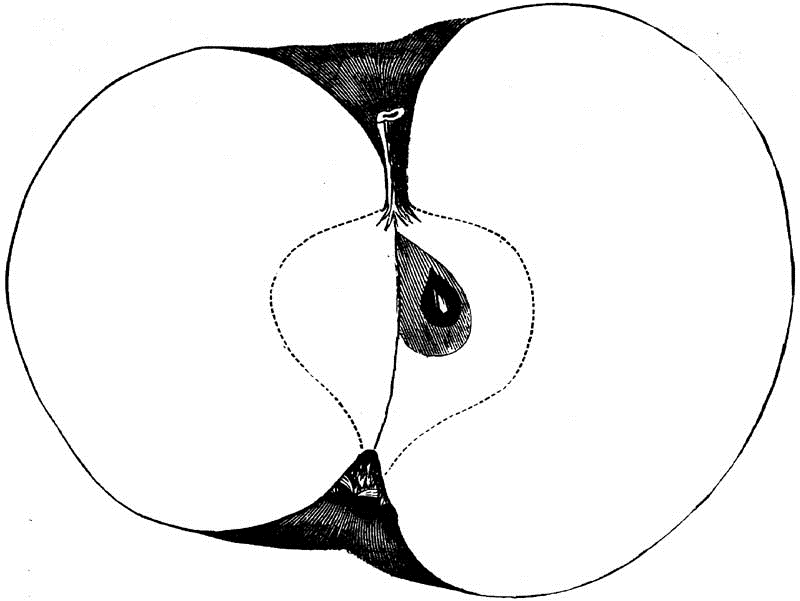
Fig. 172.—BUCKINGHAM.
This favorite southern apple, from Louisa County, Virginia, has worked its way northward into public favor at rapid rate, under the influence of railways and Pomological Societies. It was first presented to the American Society at the Philadelphia meeting, in 1860, when it was figured and reported on by the Committee on Native Fruits, to some of whom, as to thousands of others in the West, it was familiar as household words. This fruit was brought by settlers to Southern Illinois, and thence distributed, by taking up the sprouts that formed about the base of the stocks, and setting them out for an orchard. I have some of these growing, and they make nice plants.
Tree vigorous, upright, compact while young, spreading with the weight of fruit, never large; the shoots rather slender, red, dark; Leaves medium, rather narrow, wider towards the end, dark, footstalks red. The stems of these trees are characterized by curious enlargements of an irregular, mammellar form, and reddish color, and appear to be like the knaurs of the olive tree.
When this apple was first brought to the notice of the Cincinnati Horticultural Society, twenty years ago, it was thought to resemble the Winter Queen of Kentucky so closely that it was considered only a variety or sport, and called the Striped Fall Queen, but it has since been deemed a distinct sort.
Fruit large to very large, variable in form, but generally conical, or oblate-conic, truncated, angular; Surface smooth, greenish-yellow, mixed and striped pale purplish-red; Dots scattered, prominent, yellow.
Basin deep, abrupt, wavy; Eye large, long, open.
Cavity wide, wavy, brown; Stem short.
Core large, regular, closed; Axis very short; Seeds numerous, long, pointed; Flesh yellow, tender, fine-grained, juicy; Flavor mild sub-acid, rich, agreeable; Quality best, or nearly so; Use, table, kitchen, drying; Season, October to December.
Esopus Spitzenberg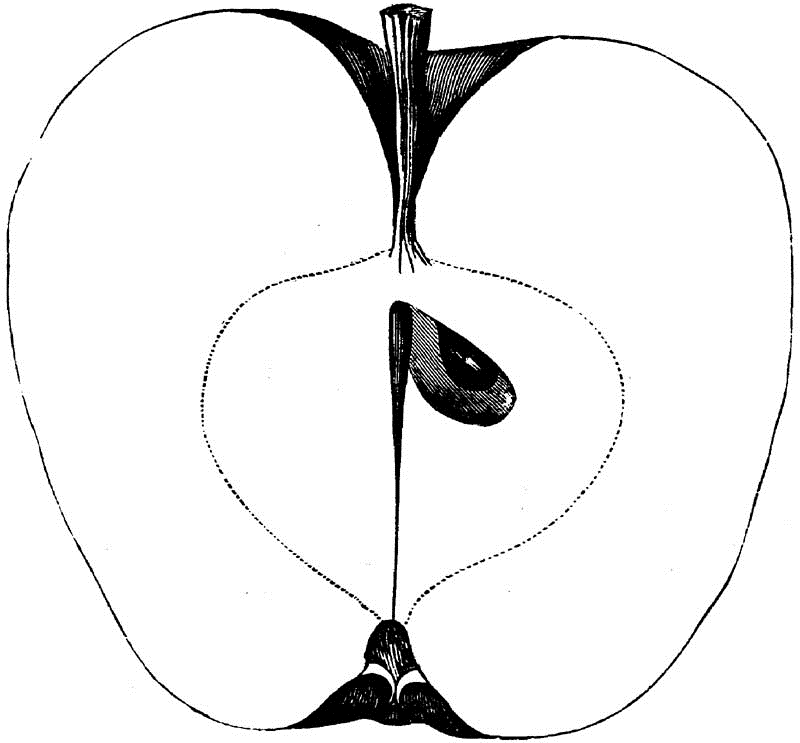
Fig. 173.—ESOPUS SPITZENBERG.
Origin New York, on the Hudson. This fruit has changed its character in progressing westward and southward, becoming larger and more irregular, less brilliantly colored, less highly flavored, and less productive.
Tree vigorous, upright, thrifty, but in some regions subject to blight and unprofitable; Shoots slender.
Fruit medium to large, conical, ribbed, irregular; Surface smooth, yellow, covered with bright red, marbled and mixed, striped more or less distinctly; Dots numerous, large, irregular, gray, always elongated near the base.
Basin deep, ribbed or folded, often leather-cracked; Eye small, closed.
Cavity deep, acute, regular, or wavy; Stem long.
Core large, closed; Seeds long, pointed; Flesh rich, yellow, breaking, juicy at the North, more fibrous than crisp at the South; Flavor quite acid till ripe, when it is rich, saccharine, highly aromatic, giving the idea of the Spitzenberg flavor; Quality best; Use, dessert and kitchen; Season, December to February.
LansingburghThe origin of this long-keeper has not been traced. It has been common about Cincinnati, and along the Ohio River, for many years.
Tree upright, vigorous, brushy and thorny, looking like a wilding.
Fruit medium, conical, angular, oblique, often unequal; Surface smooth, green and yellow, bronzed and blushed, becoming very rich yellow and carmine—an indistinct gray-striping makes the ripe fruit appear to be striped yellow; Dots minute, indented, gray, with green bases.
Basin deep, plaited or folded; Eye small, closed.
Cavity acute, irregular, rough with brown; Stem short.
Core small, oval, closed; Seeds numerous, large; Flesh firm, compact; Flavor mild sub-acid, negative; Quality scarcely good; Use, market, ornamental, cooking; Season in the kitchen all winter—ornamental and eatable March to May, or later.
Late StrawberryAUTUMN STRAWBERRYThe origin of this choice fruit appears to be unknown.
Tree upright, productive, thrifty, leaves serrate.
Fruit medium, roundish, conical, angular, furrowed; Surface smooth, waxen-yellow, mixed and striped scarlet; Dots minute, indented.
Basin folded, irregular; Eye medium, closed.
Cavity acute, wavy, irregular; Stem slender, long.
Core medium, regular, closed, Seeds large; Flesh yellow, very tender, fine-grained, very juicy; Flavor sub-acid, aromatic, refreshing, vinous; Quality best; Use, dessert especially; Season, August and September.
There is another similar fruit—the Frank or Chenango Strawberry, which is by some preferred to this.
Northern Spy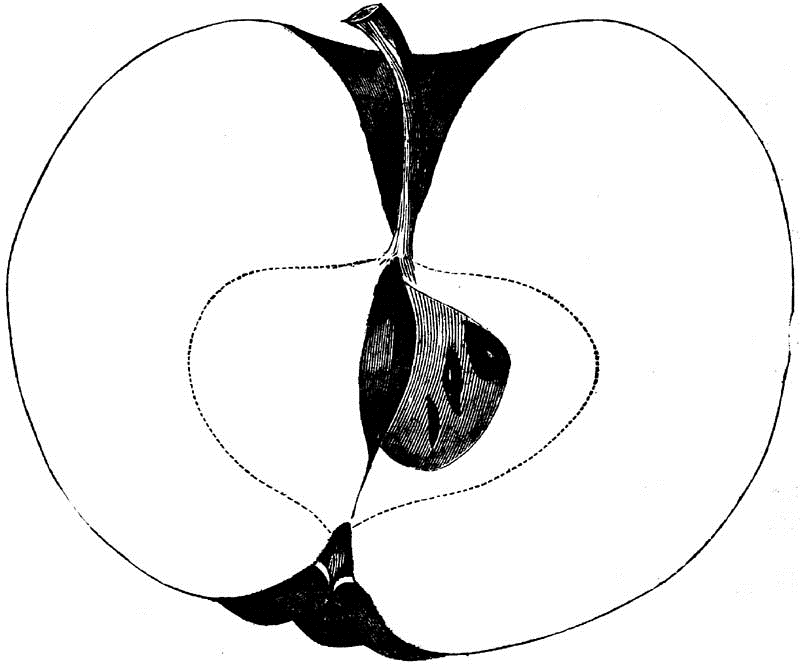
Fig. 174.—NORTHERN SPY.
Origin near Rochester, New York. Tree very vigorous, large, upright, spreading, when older; shoots reddish, leaves healthy, large, dark. Tree productive when old, but not an early bearer; needs trimming to admit light and air to the fruit.
Fruit large, flattened-conical, angular; Surface smooth, yellow, mixed, and splashed, scarlet, or crimson; Dots scattered, small.
Basin abrupt, regular, or folded; Eye small, closed.
Cavity wide, regular or wavy, brown; Stem medium to short.
Core large, irregular, open; Seeds numerous, small, pointed, pale; Flesh yellowish-white, breaking, granular, juicy; Flavor acid, becoming sub-acid, aromatic, rich, with the spiciness of a Spitzenberg; Quality considered best, but rather coarse in texture; Use, table, kitchen and market; Season, December until May, and in the North longer.
Red CanadaSTEEL'S REDOrigin New England. Tree thrifty, healthy, but slender, twiggy, productive.
Fruit medium, globular-conic, indistinctly angular; Surface smooth, yellow, covered with mixed and striped bright red; Dots numerous, gray, indented, elongated near the stem, as in Esopus.
Basin shallow, folded; Eye small, closed.
Cavity wide, acute, wavy; Stem long, inclined.
Core regular, closed, large; Seeds imperfect; Flesh yellowish-white, breaking, crisp, fine-grained, tender, juicy; Flavor sub-acid, aromatic, delicious; Quality best, for table; Season, December to February.
Red StripeEARLY RED MARGARET (incorrectly)—ROCKHILL'S SUMMER QUEEN (Indiana)This handsome and productive early apple has been extensively propagated in parts of Indiana, under the names above presented. It was introduced at Fort Wayne by Mr. Rockhill, who is reported to have "made more money from the trees of this variety than from twice as many of any other early apple." Recommended for general cultivation in that State.
Tree hardy in nursery and orchard, productive; Shoots very downy.
Fruit medium to small, long, conical, furrowed or ribbed; Surface polished, pale yellow, mixed and splashed crimson.
Basin very shallow, plaited; Eye very small, closed.
Cavity acute, regular, browned; Stem medium.
Core long, oval, embracing the eye; Flesh whitish, tender, fine-grained, juicy; Flavor acid; Quality good; Table or kitchen; Season, July and August.
Scalloped GilliflowerThis is supposed to be an old European variety. Its peculiarly irregular form makes it quite a remarkable fruit. It is sometimes called Red Gilliflower; but that name is also very commonly applied to quite another fruit—the Red Winter Pearmain, described on a previous page, in Class II., Order I., Section 2., Sub-section 2.
Fruit large, round-conic, very irregular, furrowed and ribbed; Surface yellow, marbled and splashed scarlet.
Basin abrupt, deep, folded or ribbed; Eye medium, closed.
Cavity deep, acute, irregular, wavy; Stem medium.
Core regular, round, very open, meeting the eye; Seeds numerous, plump; Flesh yellow, breaking, tender; Flavor sub-acid, aromatic; Quality scarcely good; Use, table, kitchen; Season, November, December. Chiefly grown northward.
SeagerThis large, handsome fruit was exhibited at the American Pomological Society's meeting at Philadelphia, in 1860, by Chas. P. Davis, of Phillipsburgh, New Jersey. The Committee reported it "Good."
Fruit large, roundish-conic, irregular; Surface smooth, yellow, striped, splashed and mixed carmine; Dots scattered, yellow.
Basin abrupt, narrow, folded, plaited; Eye medium, large, closed.
Cavity wide, wavy, brown and yellow; Stem medium, knobby.
Core roundish, open, clasping; Seeds angular, imperfect; Flesh yellowish-white, breaking, fine-grained, juicy; Flavor sub-acid, aromatic; Quality good to very good; Use, table, kitchen; Season, September.
Stanard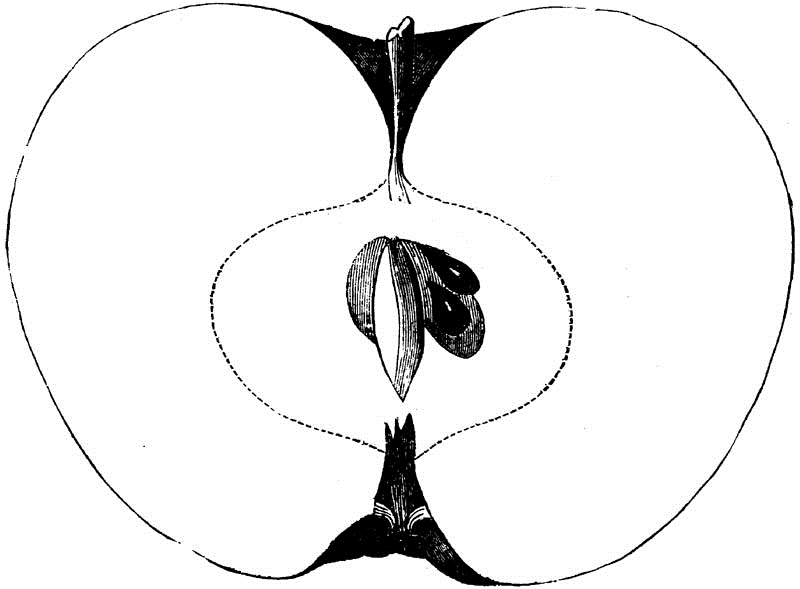
Fig. 175.—STANARD.
From Erie County, New York, this fruit has made its way westward, by the Lakes, having been distributed by Col. Hodge, of Buffalo, and brought to the notice of his western friends by Hon. M.L. Dunlap, of Champaign, Illinois, who esteems it very highly. I quote from his account of it:
"This proves one of our most profitable winter apples; the tree bears young and constantly, but fuller on alternate years; fruit large and showy, shoots large and downy; buds prominent, fruit buds large, and the earliest in the orchard to swell; but they do not open as soon as others. Tree spreading, trunk generally crooked." Very hardy.
Fruit large, roundish, conical, ribbed, angular; Surface smooth, yellowish-green, somewhat red, mixed and striped indistinctly; Dots numerous, minute, white.
Basin medium, folded and plaited; Eye large, closed; Segments long.
Cavity wide, acute, wavy, green; Stem medium to long.
Core small, globular, regular, closed or open; Seeds numerous, brown, angular; Flesh yellow, breaking, rather coarse, tender; Flavor acid to sub-acid, rich; Quality good; Use, market and table; Season, November to February.
Summer Queen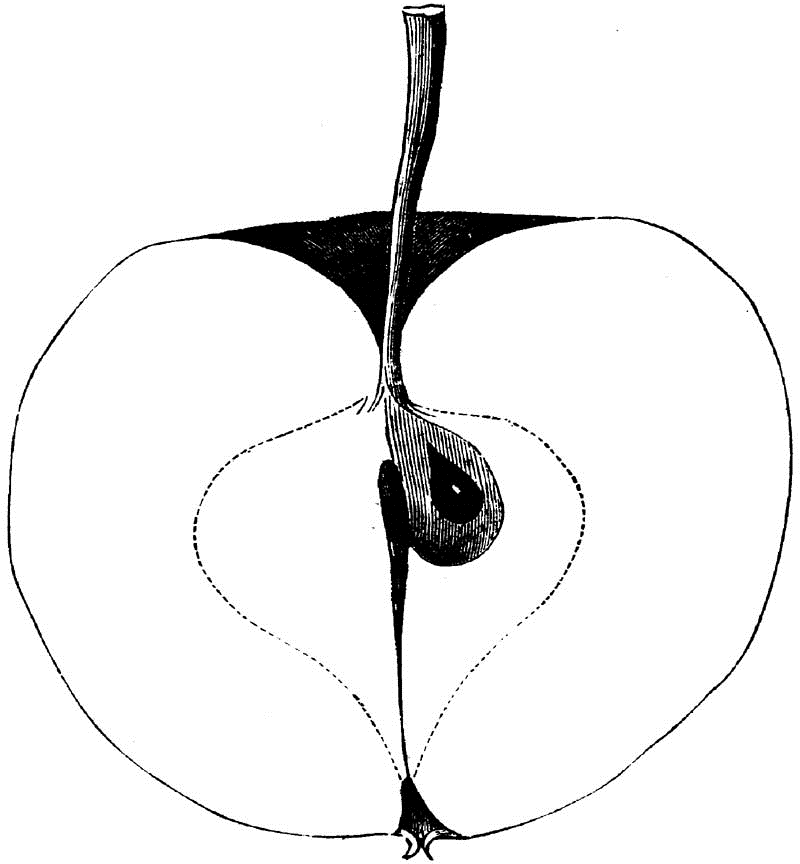
Fig. 176.—SUMMER QUEEN.
American. Tree vigorous, large, spreading, productive.
Fruit medium, round-conic, angular; Surface yellow, covered mixed red, striped, splashed scarlet; Dots minute, yellow.
Basin none or very shallow, folded or plaited; Eye medium, closed.
Cavity wide, regular, brown; Stem long, slender.
Core medium, regular, open; Seeds numerous, pointed, brown; Flesh firm, yellow, breaking; Flavor acid, very aromatic, spicy; Quality first rate; Use, kitchen; Season, July, August.
Winesap.—[Coxe.]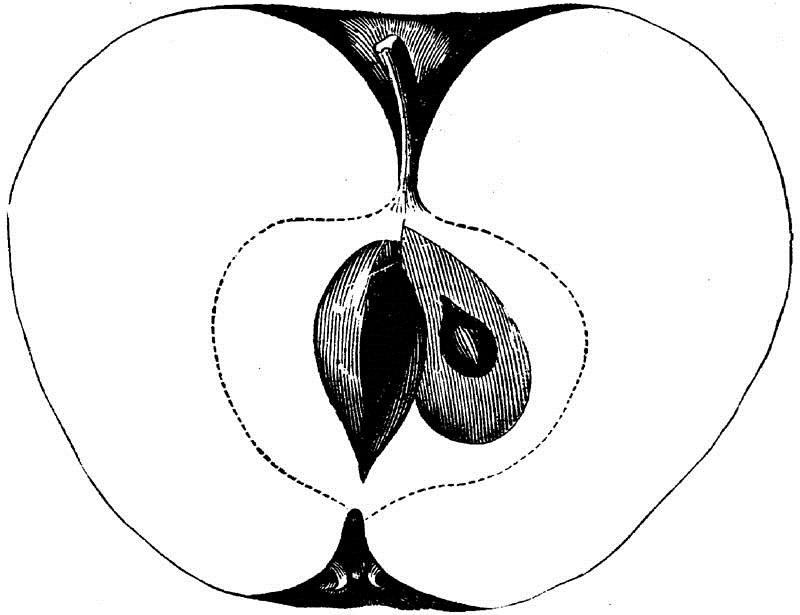
Fig. 177.—WINESAP.
Tree vigorous, healthy, hardy, productive, early bearer; Branches open, straggling; Shoots strong, dark reddish-brown; Foliage curled, glaucous, sparse.
Fruit medium, conical, often obscurely angular, or slightly ribbed; Surface rather smooth, bright or dark red, mixed and obscurely striped on yellow, which is mostly covered, often veined russet; Dots few, minute, indented.
Basin narrow, shallow, plaited; Eye small, closed.
Cavity wide, reddish brown; Stem medium.
Core regular, somewhat open; Seeds large, rather light; Flesh firm, yellow; Flavor rich, acid to sub-acid; Use, market, kitchen, cider; Season, January to March.
CLASS II.—CONICAL APPLESORDER II.—ANGULARSECTION 2.—SOURSUB-SECTION 3.—RUSSETFort Miami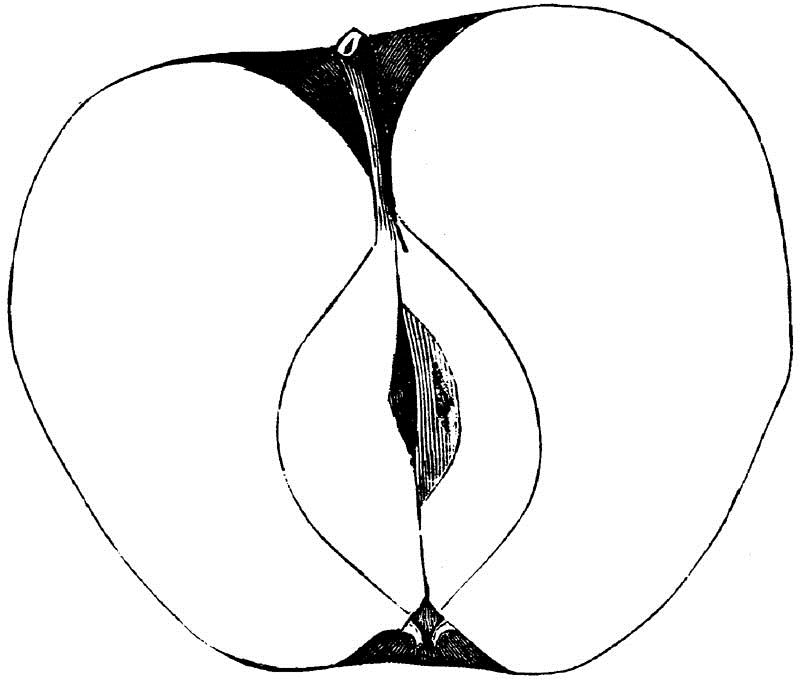
Fig. 178.—FORT MIAMI.
This is another of the seedling russets of the Maumee, brought to the notice of the State Society by its Vice-President, J. Austin Scott, of Toledo. Mr. Elliott describes it from notes taken in 1846, when he received specimens from A. Spafford, Esq., Perrysburgh, Ohio.
Tree upright and spreading, healthy, thrifty; Shoots dark; not an early bearer, but productive when older.
Fruit medium, roundish or oblong-conic, truncated, angular, often unequal; Surface rich yellow russet, often bronzed; Dots scattered, netted russeting.
Basin medium or shallow, folded; Eye small, closed.
Cavity acute, wavy, green; Stem medium.
Core oval, clasping the eye, regular, closed; Seeds often imperfect; Flesh greenish-yellow, firm; Flavor acid, rich; quality nearly best; Use, dessert; Season, February to April.
CLASS III.—ROUND APPLESORDER I.—REGULARSECTION 1.—SWEETSUB-SECTION 1.—SELF-COLOREDBluff Sweet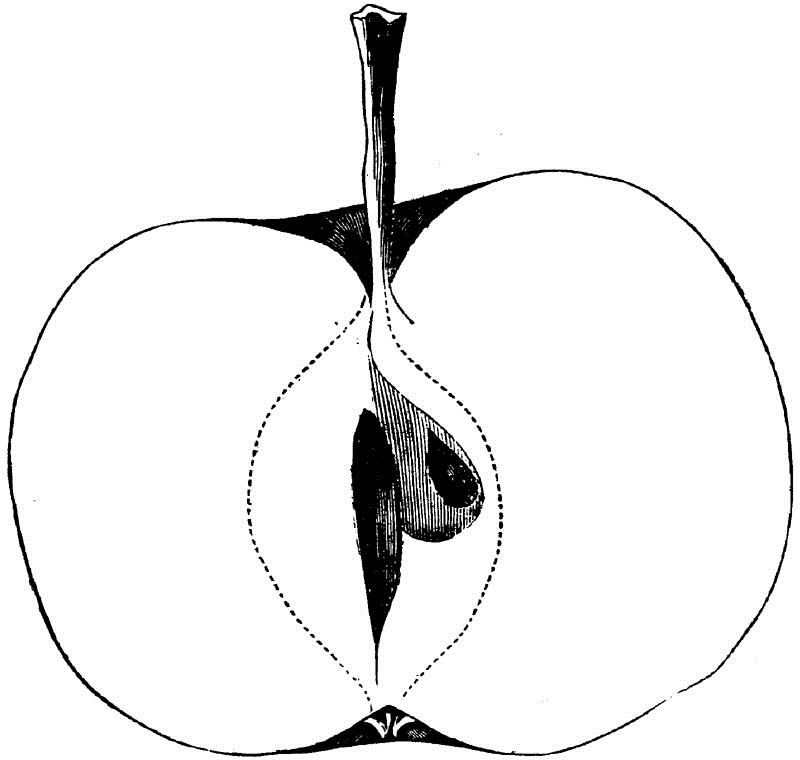
Fig. 179.—BLUFF SWEET.
This apple was found by G.M. Beeler on the banks of the White river, upon a farm devoted to pomology.
Fruit medium to small, regular, round; Surface smooth, green; Dots minute.
Basin shallow; Eye small, closed.
Cavity shallow, regular; Stem long.
Core small, oval, pointed; Seeds plump, brown; Flesh greenish-white; Flavor sweet; Quality good; Use, market; Season, July. Rather too small.
Broadwell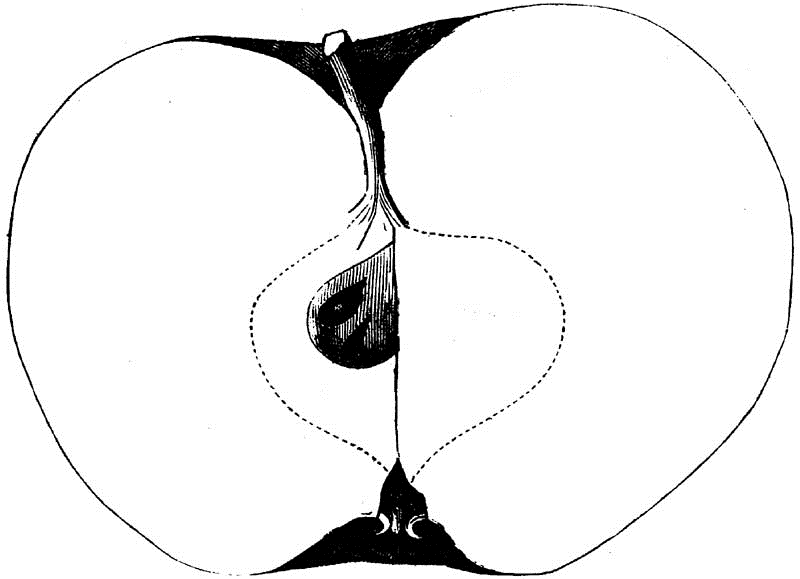
Fig. 180.—BROADWELL.
This delicious winter sweet apple originated near Cincinnati, Ohio. Tree thrifty, vigorous, spreading, productive.
Fruit large, varies from globular toward oblate, regular; Surface smooth, pale yellow or whitish, thinly blushed with carmine, often bronzed; Dots scattered, minute, dark.
Basin abrupt, rarely folded or plaited; Eye small, closed.
Cavity wide, regular brown; Stem short.
Core round, regular, closed, clasping the eye; Seeds short, plump; Flesh yellowish, fine-grained, very tender, juicy; Flavor very sweet, agreeable; Quality best winter sweet; Use, table, kitchen; Season, December.
Caleb"A Pennsylvania fruit. Tree vigorous and productive; Fruit medium, roundish, flattened, skin yellow; Flesh rather fine, very sweet, excellent for cooking. Last of August and first of September".—[Downing.]
Danvers' Winter Sweet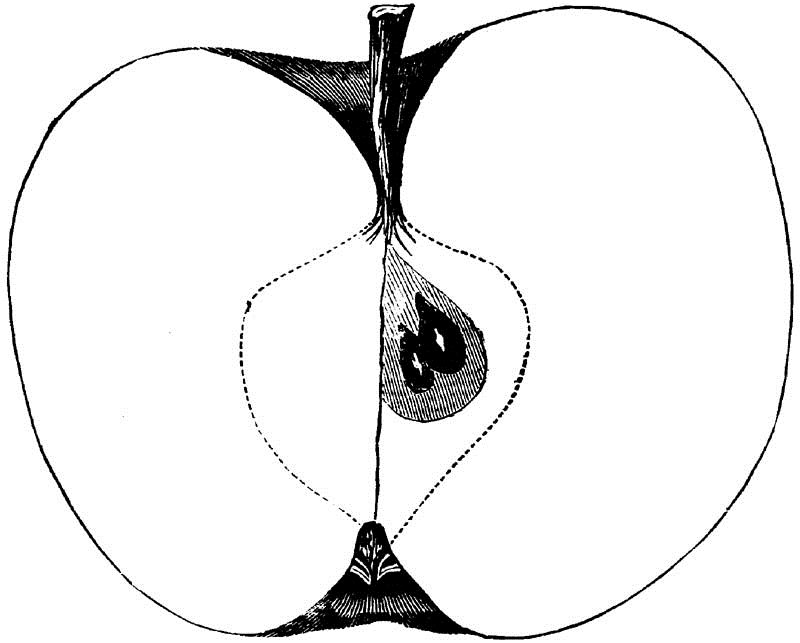
Fig. 181.—DANVERS' WINTER SWEET.
Origin Danvers, Massachusetts. Tree very thrifty, very productive.
Fruit large, globular, truncate, sometimes globular-oblate, regular; Surface smooth, uneven, greenish-yellow; Dots numerous, medium, prominent, with white and green bases.
Basin abrupt, deep, regular; Eye small, closed; Segments long.
Cavity wide, deep, brown; Stem long, slender, knobby.
Core round, regular, closed; Seeds numerous, long, brown, pointed; Flesh yellow, breaking, fine-grained, juicy; Flavor very sweet; Quality good to very good; Use, baking; Season, December and January.
FancherThis new fruit was obtained from Mr. Thomson, at the State Fair at Zanesville, Ohio. Origin unknown. Not identified nor recognized.
Fruit large to very large, globular, regular; Surface smooth, yellow, blushed; Dots minute, scattered.
Basin shallow, regular; Eye small, closed.
Cavity acute, regular, green; Stem long, inclined.
Core wide, round, open, meeting the eye; Seeds numerous, plump, brown; Flesh white, fine-grained, breaking, juicy; Flavor very sweet; Quality good to very good; Use, baking; Season, September and October.
Golden SweetORANGE SWEETING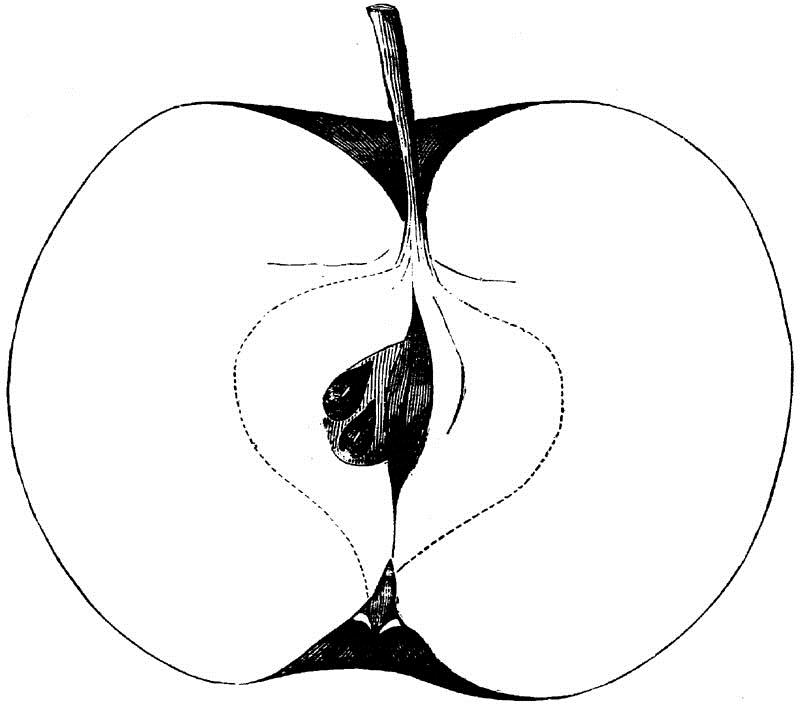
Fig. 182.—GOLDEN SWEET.
From Connecticut. Tree very robust, vigorous, spreading, round-head, early—productive; Shoots stout, dark, foliage large, dark.
Fruit large, globular, regular; Surface very smooth, waxen to rich yellow; Dots scattered, indented, green.
Basin shallow, wide regular; Eye medium, closed; Calyx reflexed.
Cavity wide, regular; Stem long, slender, yellow.
Core medium, regular, closed; Seeds numerous, small, pointed, light brown; Flesh yellow, breaking, fine-grained, juicy; Flavor very sweet, aromatic, like sassafrass; Quality good to very good; Use, baking and market; Season, August.
Higby SweetLADY BLUSH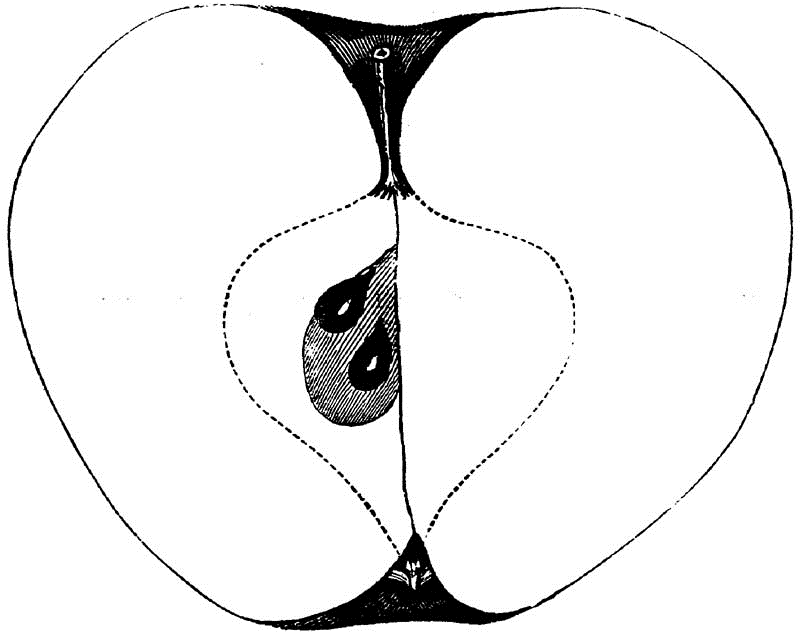
Fig. 183.—HIGBY SWEET.
Origin Trumbull County, Ohio; introduced by Dr. Kirtland.
Fruit large, round, truncated, regular; Surface smooth, greenish-yellow, blushed; Dots scattered, distinct, white and dark.
Basin abrupt, wavy, deep; Eye medium, closed.
Cavity deep, acute, regular, brown; Stem medium.
Core small, regular, heart-shaped, closed, clasping the eye; Seeds plump; Flesh yellowish-white, tender, fine-grained, juicy; Flavor very sweet; Quality good; Use, baking; Season, October.
Hightop SweetSWEET JUNEFrom Plymouth, Massachusetts.
Tree vigorous, very upright, exceedingly productive and profitable.
Fruit small to medium, round, regular; Surface smooth, greenish-yellow; Dots minute, black.
Basin medium, regular; Eye small, closed.
Cavity deep, narrow; Stem medium.
Core very small, oval, separate from the eye; Seeds numerous, angular, yellow; Flesh white, or greenish-white, fine-grained, tender, juicy; Flavor sweet; Quality good; Use, table and kitchen; Season, June and July.
Holston SweetOrigin unknown. Not identified as any other variety; received from my brother, J.T. Warder, Springfield, Ohio.
Fruit medium to large, round, regular; Surface smooth greenish-yellow, bronzy; Dots scattered.
Basin regular, small; Eye small, closed.
Cavity shallow, wide; Stem long to medium.
Core small, oval, regular, closed, clasping; Seeds short, plump, brown; Flesh whitish-yellow, very fine-grained, tender, juicy; Flavor very sweet, aromatic, rich; Quality best; Use, table, baking; Season, December to February.
One of the best sweet table apples—better than Higby Sweet.
MayMAY (of Myers)—RHENISH MAY (of Illinois.)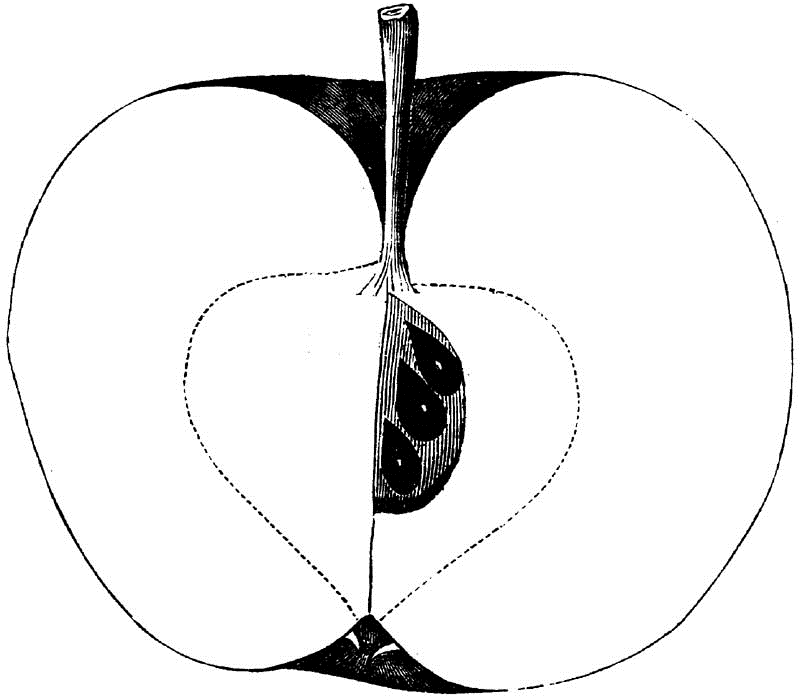
Fig. 184.—MAY.
This long-keeping apple has been widely disseminated throughout the West, and yet I do not find its history nor origin. It has been exhibited at all our winter meetings, and finds favor on account of its productiveness and its long-keeping properties. Tree healthy, vigorous and productive—believed to be hardy. Its reputed foreign origin is discredited.
Fruit medium, round, inclined to conical, regular; Surface smooth, often shining, pale greenish-yellow, often faintly blushed, or bronzed.
Basin shallow, generally regular; Eye small, closed.
Cavity deep, narrow, regular, brown; Stem long, rather slender.
Core large, regular, heart-shaped, reaching the eye; Seeds numerous, pointed, plump, brown; Flesh yellow, compact, fine, sufficiently juicy; Quality fair; Use market and kitchen; Season spring and into summer.
Morton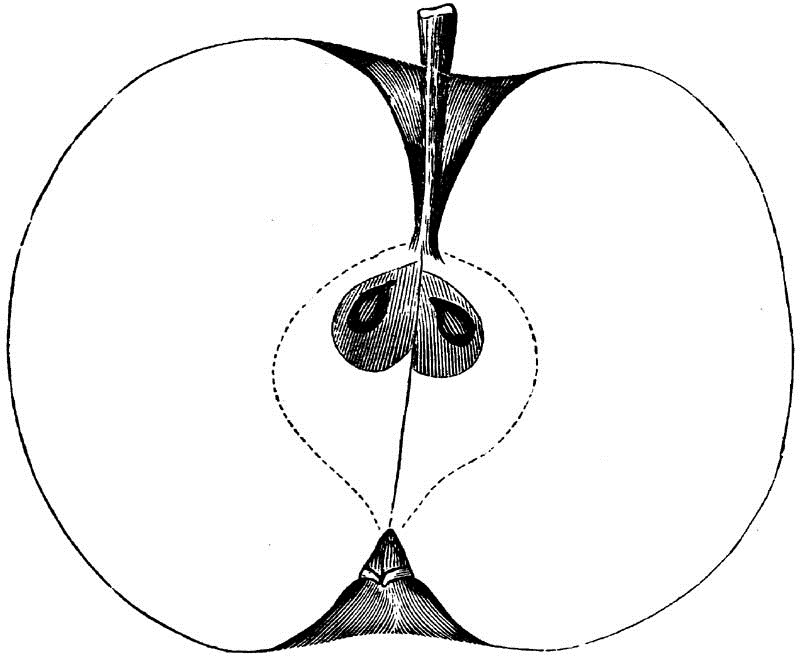
Fig. 185.—MORTON.
This undescribed fruit appears to have originated in Clermont County, Ohio. My specimens and trees came from my worthy friend, Wm. E. Mears, of Milford, Ohio.
Tree vigorous, healthy, round top, spreading, productive; Shoots rather slender; Leaves rich green, abundant.
Fruit large, round, regular; Surface smooth, green, becoming yellow, with a dull bronzy blush; Dots gray and brown.
Basin shallow, or deep and abrupt, regular or plaited; Eye medium, closed.
Cavity acute, regular, brown; Stem rather slender, often long.
Core very small, regular, closed, meeting the eye; Seeds not numerous, flat, angular; Flesh white, tender, juicy; Flavor rather sweet, rich, agreeable; Season December to January. Worthy of cultivation.
Paradise Summer Sweet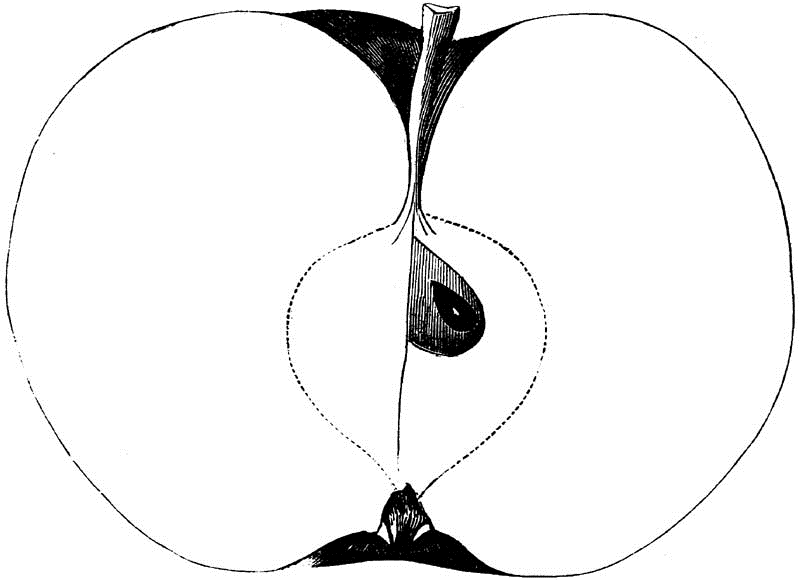
Fig. 186.—PARADISE SUMMER SWEET.
Origin Eastern Pennsylvania. Tree upright, vigorous, productive.
Fruit large, oblate-globular, regular; Surface greenish-yellow; Dots numerous, large, white.
Basin shallow, wide, folded; Eye small, closed.
Cavity deep, regular, acute, green; Stem long, inclined, yellow.
Core medium, regular, round, clasping; Seeds plump; Flesh yellow, melting, juicy; Flavor rich, sweet; Quality best; Use table and kitchen; Season August, September.
Paradise Winter Sweet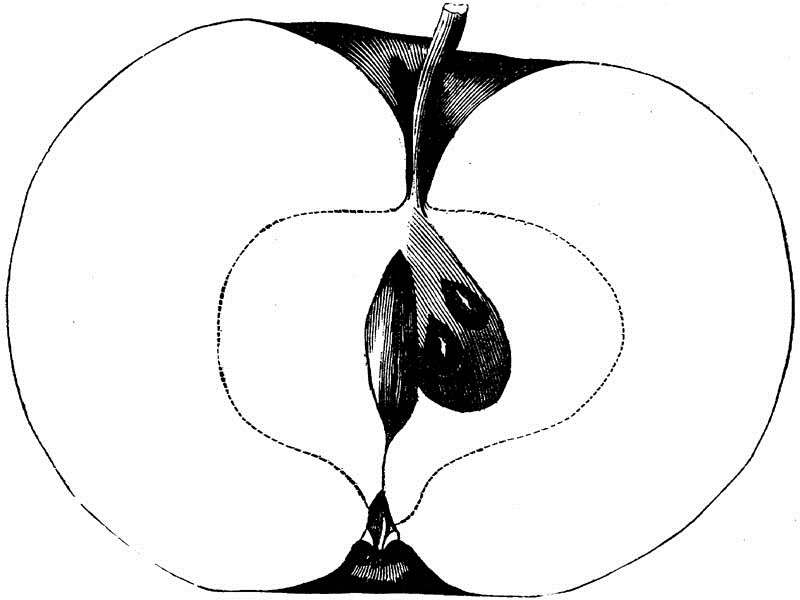
Fig. 187.—PARADISE WINTER SWEET.
Origin believed to be similar to its predecessor—Lancaster County, Pennsylvania.
Fruit large, globular, often unequal; Surface smooth, yellowish-white; Dots scattered, minute.
Basin abrupt, regular; Eye small, closed.
Cavity deep, acute, brown; Stem long, slender.
Core large, wide, open, clasping; Seeds plump and dark; Flesh white, tender, breaking, juicy; Flavor very sweet; Quality good; Use, baking and stock; Season, December to March.
Tallman's Sweet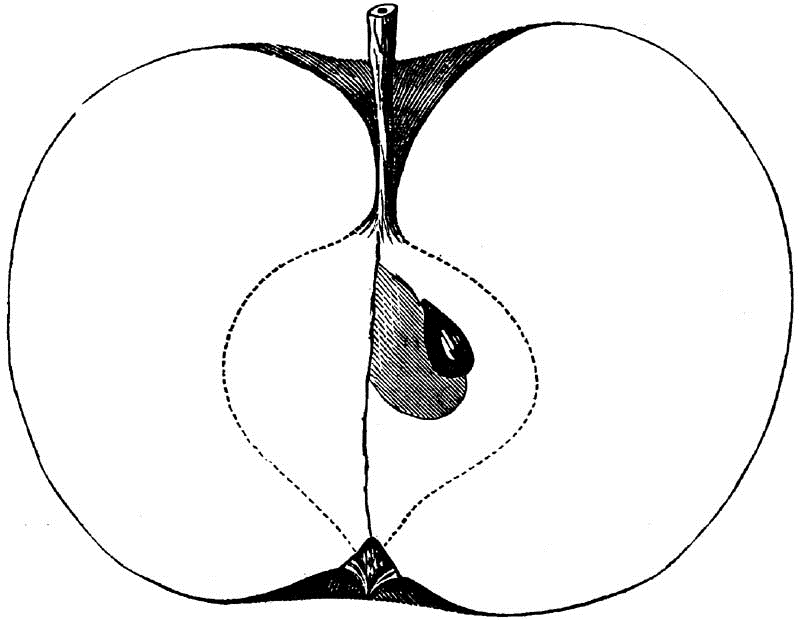
Fig. 188.—TALLMAN'S SWEET.
This favorite baking apple of New England has traveled from Rhode Island wherever her hardy sons have gone westward.
Tree hardy, very productive.
Fruit medium to large, nearly round, somewhat flattened, regular; Surface smooth, yellow; Dots minute, dark; frequently a distinct line on one side from stem to eye.
Basin wide, regular, leather-cracked; Eye small, closed.
Cavity rather wide, regular; Stem medium size, long.
Core heart-shaped, regular, closed, clasping; Seeds numerous, plump, pointed, dark; Flesh yellow, breaking, firm; Flavor very sweet, rich; Quality good; Use, baking and stock; Season, December and January.
CLASS III.—ROUND APPLESORDER I.—REGULARSECTION 1.—SWEETSUB-SECTION 2.—STRIPEDBentley SweetThis long-keeping sweet apple was received in Eastern Ohio from some part of Virginia, where it is supposed to have originated.



